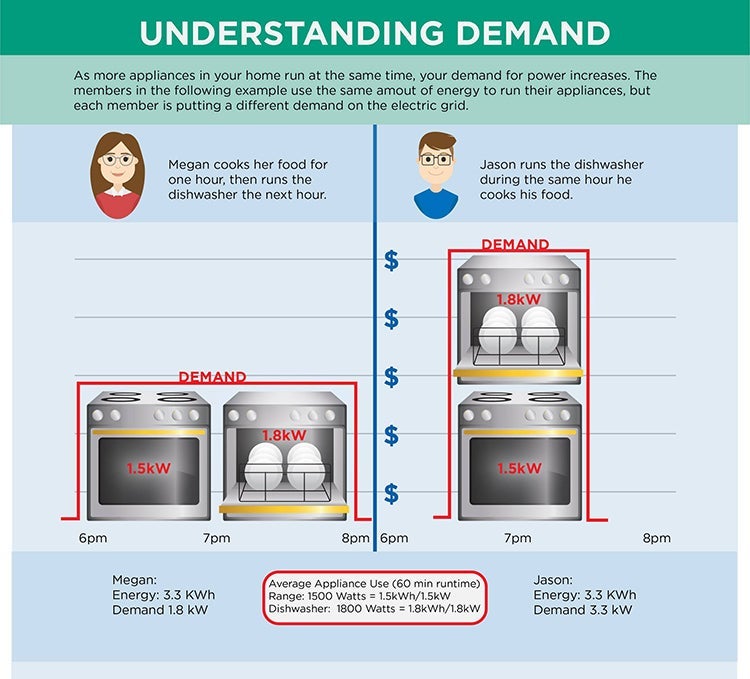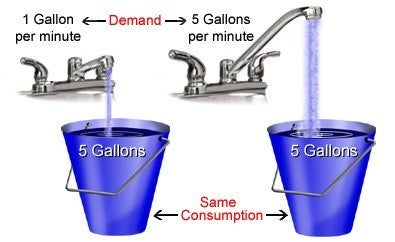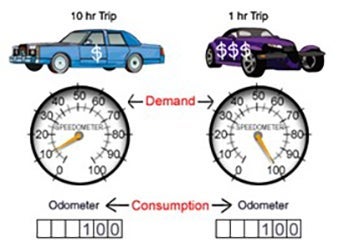What is Demand

What is demand? Demand is the rate at which a person utilizes electricity. Demand increases when many large or power-hungry appliances operate simultaneously. In these instances, Flint Hills REC must have the infrastructure to ensure enough power is available to the members’ home or business to satisfy their current need for immediate electricity. Flint Hills REC’s system must be built to supply energy at maximum demand for each member. It is important to remember that demand is not the total amount of energy used; it is the rate at which it is being used.
What are some examples of demand? Electric demand refers to the maximum amount of electrical power that is being consumed at a given time, as opposed to energy which is the amount of power used over a period of time. For example, your electric range/oven requires, or demands, 1,500 watts of power. If that range/oven is used for two hours, it consumes 3,000 watt-hours or 3 kilowatt-hours of energy (1,500 watts times 2 hours equals 3,000 watt-hours).
Using multiple appliances at the same time increases your demand. A typical dishwasher has a demand of 1,800 watts. If you used the dishwasher at the same time as the range/oven, the total demand for these two appliances would be 1,800 watts plus 1,500 watts or 3,300 watts. If instead you choose to operate these at separate times, the maximum demand for these two appliances would only be 1,800 watts.

Another way of understanding demand and consumption is with a "filling the bucket" analogy. Suppose you want to fill a 5 gallon bucket with water. You can use an inexpensive hose connection to your sink providing 1 gallon per minute to do it, and it will take 5 minutes. Or you can get to a more expensive large faucet that provides 5 gallons per minute, it will fill in just one minute. The flow rate is the equivalent to demand, and the 5 gallons of water are equivalent to consumption.
In this example, filling both buckets has the same "consumption" but very different "demands."
The same is true of electricity. While you may be able to accomplish the same thing by operating a small wattage appliance for many hours as operating something of higher wattage for just a few, the higher wattage piece of equipment will create a higher demand on the utility.
Using our analogy, you are asking for a larger pipe, and that costs more. If time is of the essence, it might be worth having the more expensive high flow rate or wattage. This is why utilities often charge some customers for both demand and consumption. A customer that sets a high demand requires more services from the utility--additional generating plant capacity, and more expense in lines, transformers, and substation equipment.

Some people like to use an automobile analogy to explain and understand how demand and consumption relate. The car's speedometer is like the demand meter and the odometer is like a consumption meter. Two cars could travel the same 100-mile road, one at 10 miles per hour for 10 hours and the other at 100 miles per hour for 1 hour. It takes a much more capable and expensive engine to power the car at 100 miles per hour than it does to power the one going only 10 miles per hour.
How does Demand affect Flint Hills REC? Demand has a significant impact on Flint Hills REC in multiple ways. Higher demand increases the size of transformers and other equipment needed for Flint Hills REC to deliver electricity to our members. Larger equipment typically costs more to own and maintain. Demand also has an impact on our wholesale electric bill. In 2021 variable demand charges accounted for nearly one third of what Flint Hills REC paid for wholesale electricity for our members.
Is Demand new? Yes and no. Historically, demand-related costs were included in the kWh energy charge to residential and small commercial members. Demand readings are now readily available for residential and small commercial members because of the investments we have made in automated metering.
Is Demand on my bill? Yes, starting with the November 1st bill you will be able to see what your monthly demand is. You will see this as a charge of $1.50/kW on your bill.
How can I control my Demand? Depending on your operation, there may be several ways you can reduce your demand on the electric system. Does all of your equipment need to be running at the same time? What energy efficiency improvements can be made?
Try to be aware of what appliances are running in your home. For instance, try not to run the clothes dryer and dishwasher at the same time. The more you can manage how you run your appliances will help reduce your demand.
For more information on Demand please feel free to call our office at 620-767-5144.
